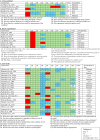Trunk kinematics during seated functional activities in individuals with spinal cord injury: a systematic review and meta-analysis
- PMID: 40596122
- PMCID: PMC12219815
- DOI: 10.1038/s41598-025-06765-5
Trunk kinematics during seated functional activities in individuals with spinal cord injury: a systematic review and meta-analysis
Abstract
This systematic review with meta-analysis compared the differences in trunk kinematics between persons living with spinal cord injury (PwSCI) and non-SCI individuals during sitting-based daily activities. A systematic search was conducted in MEDLINE, EMBASE, CINAHL-PLUS and Web of Science databases to identify relevant studies from inception up until 22nd March 2024. A total of 36 studies with 444 participants (mean age 38.9 ± 8.4 years; 361 males) were included, of whom 272 had AIS A/B classification, with injury levels ranging from C4 to L2. Three main tasks were identified: reaching, transfers, and wheeling. Four studies reported data on trunk displacement and a meta-analysis indicated that healthy controls showed significantly greater trunk displacement than SCI participants in forward-reaching tests (SMD = 2.07; 95% CI = 0.42-3.72; P = 0.01). Forward flexion and trunk rotation might be useful strategies to compensate for muscle weakness during transfers and wheelchair propulsion. SCI participants showed reduced trunk displacement during reaching compared to controls, indicating impaired trunk control and sitting balance. Transfer and wheeling trunk strategies vary based on muscle function. Further research on trunk kinematics is needed to guide rehabilitation tailored to individual abilities.
Keywords: Paraplegia; Reaching; Tetraplegia; Transfer; Wheeling.
© 2025. The Author(s).
Conflict of interest statement
Declarations. Ethical approval: Ethical review was not required for this project as it is a systematic review of published literature and does not contain patient information. Competing interests: The authors declare no competing interests.
Figures




Similar articles
-
Automatic application of neural stimulation during wheelchair propulsion after SCI enhances recovery of upright sitting from destabilizing events.J Neuroeng Rehabil. 2018 Mar 12;15(1):17. doi: 10.1186/s12984-018-0362-2. J Neuroeng Rehabil. 2018. PMID: 29530053 Free PMC article. Clinical Trial.
-
Systemic pharmacological treatments for chronic plaque psoriasis: a network meta-analysis.Cochrane Database Syst Rev. 2021 Apr 19;4(4):CD011535. doi: 10.1002/14651858.CD011535.pub4. Cochrane Database Syst Rev. 2021. Update in: Cochrane Database Syst Rev. 2022 May 23;5:CD011535. doi: 10.1002/14651858.CD011535.pub5. PMID: 33871055 Free PMC article. Updated.
-
Educational interventions for the management of cancer-related fatigue in adults.Cochrane Database Syst Rev. 2016 Nov 24;11(11):CD008144. doi: 10.1002/14651858.CD008144.pub2. Cochrane Database Syst Rev. 2016. PMID: 27883365 Free PMC article.
-
Influence of time since injury and physical activity level on upper limb kinematics and muscle activation during wheelchair propulsion in complete T12/L1 spinal cord injury.BMC Musculoskelet Disord. 2025 Aug 21;26(1):807. doi: 10.1186/s12891-025-08987-0. BMC Musculoskelet Disord. 2025. PMID: 40841636 Free PMC article.
-
Management of faecal incontinence and constipation in adults with central neurological diseases.Cochrane Database Syst Rev. 2013 Dec 18;(12):CD002115. doi: 10.1002/14651858.CD002115.pub4. Cochrane Database Syst Rev. 2013. Update in: Cochrane Database Syst Rev. 2014 Jan 13;(1):CD002115. doi: 10.1002/14651858.CD002115.pub5. PMID: 24347087 Updated.
References
-
- Biering-Sorensen, F., Hansen, R. B. & Biering-Sorensen, J. Mobility aids and transport possibilities 10–45 years after spinal cord injury. Spinal Cord. 42, 699–706. 10.1038/sj.sc.3101649 (2004). - PubMed
-
- New, P. W. Functional outcomes and disability after nontraumatic spinal cord injury rehabilitation: results from a retrospective study. Arch. Phys. Med. Rehabil. 86, 250–261. 10.1016/j.apmr.2004.04.028 (2005). - PubMed
-
- Robertson, J. V. & Roby-Brami, A. The trunk as a part of the kinematic chain for reaching movements in healthy subjects and hemiparetic patients. Brain Res.1382, 137–146. 10.1016/j.brainres.2011.01.043 (2011). - PubMed
Publication types
MeSH terms
Grants and funding
LinkOut - more resources
Full Text Sources
Medical
Miscellaneous

